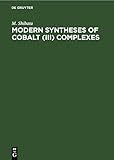Modern Syntheses of Cobalt (III) Complexes / M. Shibata.
Material type: TextPublisher: Berlin ; Boston : De Gruyter, [2022]Copyright date: 1983Edition: Reprint 2022Description: 1 online resource (130 p.) : With 44 Figures and 31 TablesContent type:
TextPublisher: Berlin ; Boston : De Gruyter, [2022]Copyright date: 1983Edition: Reprint 2022Description: 1 online resource (130 p.) : With 44 Figures and 31 TablesContent type: - 9783112620892
- 9783112620908
- 546 23/eng/20230216
- online - DeGruyter
- Issued also in print.
| Item type | Current library | Call number | URL | Status | Notes | Barcode | |
|---|---|---|---|---|---|---|---|
 eBook
eBook
|
Biblioteca "Angelicum" Pont. Univ. S.Tommaso d'Aquino Nuvola online | online - DeGruyter (Browse shelf(Opens below)) | Online access | Not for loan (Accesso limitato) | Accesso per gli utenti autorizzati / Access for authorized users | (dgr)9783112620908 |
Browsing Biblioteca "Angelicum" Pont. Univ. S.Tommaso d'Aquino shelves, Shelving location: Nuvola online Close shelf browser (Hides shelf browser)

|

|

|

|

|

|

|
||
| online - DeGruyter Van der Waals Systems / | online - DeGruyter Plasma Chemistry IV / | online - DeGruyter Inorganic Ring Systems. | online - DeGruyter Modern Syntheses of Cobalt (III) Complexes / | online - DeGruyter Chemisches Zentralblatt / Formelregister. 138. Jahrgang, 1967, Teil 1: C1—C8-Gruppe / | online - DeGruyter Chemisches Zentralblatt / Schnellreferate. 138. Jahrgang, 1967, Autorenregister und Sachregister / | online - DeGruyter Chemisches Zentralblatt / Sachregister. 137. Jahrgang, 1966, Teil III: Pfllanzen-Zytron. |
Frontmatter -- Preface -- Table of Contents -- Abbreviations -- 1 Some Modern Methods of General Syntheses -- 1.1 Significance of Preparative Work -- 1.2 Complexes with Flexible Quadridentate Ligands -- 1.3 Complexes with Macrocyclic Quadridentate Ligand -- 1.4 Complexes Containing α,ω-Alkanediamines -- 1.5 Mixed Cyano Complexes -- 1.6 References -- 2 Versatile Uses of Tricarbonatocobaltate(III) as Starting Material -- 2.1 Historical -- 2.2 Tricarbonatocobaltate(III) Anion -- 2.3 Systematic Synthesis of Complexes -- 2.4 General Syntheses of Tris(bidentate) Complexes -- 2.5 General Syntheses of Amino Acid Complexes -- 2.6 Binuclear Complexes -- 2.7 Heteropoly Electrolytes -- 2.8 Reaction Kinetics Concerning Tricarbonatocobaltate(III) -- 2.9 References -- 3 Preparative Application of Chromatography -- 3.1 Introduction -- 3.2 Chromatography on Ion-Exchange Resins -- 3.3 Chromatography on Ion-Exchange Cellulose or Ion-Exchange Dextran -- 3.4 Chromatography using Cellulose Powder, Paper, or Alumina -- 3.5 References -- 4 Stereoselectivity in Complexes with Less Puckered Chelate Rings -- 4.1 Historical Background -- 4.2 Complexes with Amino Acids -- 4.3 Optically Active Aspartate Containing Complexes -- 4.4 Mixed Diamine-Amino Acid Complexes -- 4.5 Dipeptide Complexes -- 4.6 Tris-Complexes of 3-Substituted Camphor -- 4.7 Complexes Containing Optically Active Tartaric Acid -- 4.8 References -- 5 Design of Low Symmetry Complexes -- 5.1 Introduction -- 5.2 Complexes Exhibiting Marked Splitting in the Second Absorption Bands -- 5.3 Complexes with Optical Activity Due to Unidentate Ligands -- 5.4 Chiral Complexes of the [Co(0)4(N)2]-and [Co(0)2(N)4]+Types -- 5.5 References
restricted access online access with authorization star
http://purl.org/coar/access_right/c_16ec
Issued also in print.
Mode of access: Internet via World Wide Web.
In German.
Description based on online resource; title from PDF title page (publisher's Web site, viewed 19. Oct 2024)


